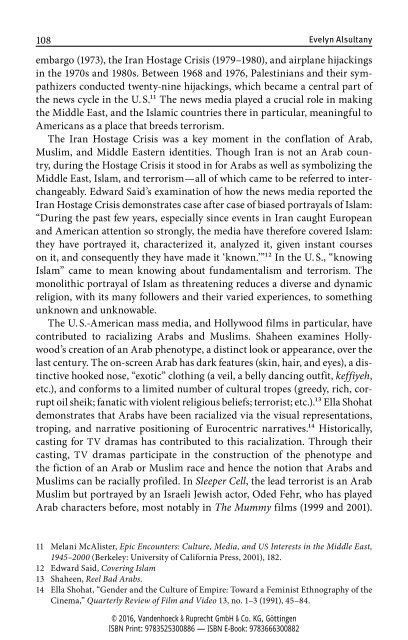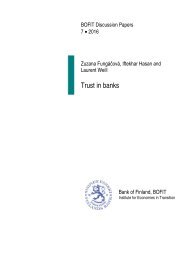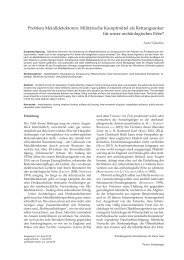Media and Minorities
9783666300882_ruhrmann_media_ebook_034247
9783666300882_ruhrmann_media_ebook_034247
Create successful ePaper yourself
Turn your PDF publications into a flip-book with our unique Google optimized e-Paper software.
108<br />
Evelyn Alsultany<br />
embargo (1973), the Iran Hostage Crisis (1979–1980), <strong>and</strong> airplane hijackings<br />
in the 1970s <strong>and</strong> 1980s. Between 1968 <strong>and</strong> 1976, Palestinians <strong>and</strong> their sympathizers<br />
conducted twenty-nine hijackings, which became a central part of<br />
the news cycle in the U. S.11 The news media played a crucial role in making<br />
the Middle East, <strong>and</strong> the Islamic countries there in particular, meaningful to<br />
Americans as a place that breeds terrorism.<br />
The Iran Hostage Crisis was a key moment in the conflation of Arab,<br />
Muslim, <strong>and</strong> Middle Eastern identities. Though Iran is not an Arab country,<br />
during the Hostage Crisis it stood in for Arabs as well as symbolizing the<br />
Middle East, Islam, <strong>and</strong> terrorism — all of which came to be referred to interchangeably.<br />
Edward Said’s examination of how the news media reported the<br />
Iran Hostage Crisis demonstrates case after case of biased portrayals of Islam:<br />
“During the past few years, especially since events in Iran caught European<br />
<strong>and</strong> American attention so strongly, the media have therefore covered Islam:<br />
they have portrayed it, characterized it, analyzed it, given instant courses<br />
on it, <strong>and</strong> consequently they have made it ‘known.’”12 In the U. S., “knowing<br />
Islam” came to mean knowing about fundamentalism <strong>and</strong> terrorism. The<br />
monolithic portrayal of Islam as threatening reduces a diverse <strong>and</strong> dynamic<br />
religion, with its many followers <strong>and</strong> their varied experiences, to something<br />
unknown <strong>and</strong> unknowable.<br />
The U. S.-American mass media, <strong>and</strong> Hollywood films in particular, have<br />
contributed to racializing Arabs <strong>and</strong> Muslims. Shaheen examines Hollywood’s<br />
creation of an Arab phenotype, a distinct look or appearance, over the<br />
last century. The on-screen Arab has dark features (skin, hair, <strong>and</strong> eyes), a distinctive<br />
hooked nose, “exotic” clothing (a veil, a belly dancing outfit, keffiyeh,<br />
etc.), <strong>and</strong> conforms to a limited number of cultural tropes (greedy, rich, corrupt<br />
oil sheik; fanatic with violent religious beliefs; terrorist; etc.).13 Ella Shohat<br />
demonstrates that Arabs have been racialized via the visual representations,<br />
troping, <strong>and</strong> narrative positioning of Eurocentric narratives.14 Historically,<br />
casting for TV dramas has contributed to this racialization. Through their<br />
casting, TV dramas participate in the construction of the phenotype <strong>and</strong><br />
the fiction of an Arab or Muslim race <strong>and</strong> hence the notion that Arabs <strong>and</strong><br />
Muslims can be racially profiled. In Sleeper Cell, the lead terrorist is an Arab<br />
Muslim but portrayed by an Israeli Jewish actor, Oded Fehr, who has played<br />
Arab characters before, most notably in The Mummy films (1999 <strong>and</strong> 2001).<br />
11 Melani McAlister, Epic Encounters: Culture, <strong>Media</strong>, <strong>and</strong> US Interests in the Middle East,<br />
1945–2000 (Berkeley: University of California Press, 2001), 182.<br />
12 Edward Said, Covering Islam<br />
13 Shaheen, Reel Bad Arabs.<br />
14 Ella Shohat, “Gender <strong>and</strong> the Culture of Empire: Toward a Feminist Ethnography of the<br />
Cinema,” Quarterly Review of Film <strong>and</strong> Video 13, no. 1–3 (1991), 45–84.<br />
© 2016, V<strong>and</strong>enhoeck & Ruprecht GmbH & Co. KG, Göttingen<br />
ISBN Print: 9783525300886 — ISBN E-Book: 9783666300882







